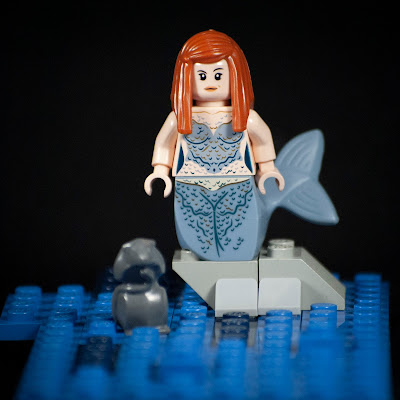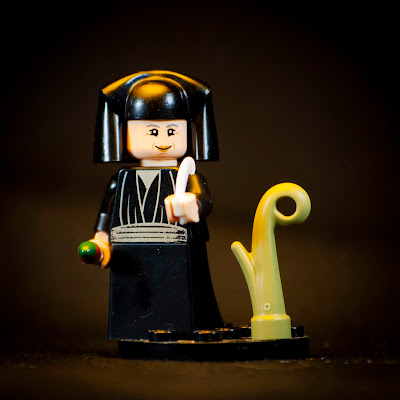St. Anthony the Great
Saint Anthony the Great -- also known as Saint Anthony the Abbott, Saint Anthony of the Desert, The Father of Monks, and others -- became one of the earliest Christian ascetics to go viral. The biography of his life was translated into Latin early on, and went on to inspire numerous others throughout the Middle Ages to found monasteries or become hermits.
Like many early saints, Anthony belonged to a rich family but gave away his wealth to the poor in order to better follow Christ's commands in the gospels. However, unlike his predecessors, Anthony went alone into the desert to live a life of isolation and prayer.
But before becoming a total hermit, St. Anthony 'merely' lived a life of self-denial and labor, working as a swineherd near town. During this work, he was tempted by demons and phantoms. They sent visions of women to challenge his chastity and boredom and laziness to challenge his resolve. In response to these challenges, St. Anthony only increased his prayer life, relying wholly on God to fight the devil on his behalf.
After that, Anthony took his asceticism even further, taking up residence in an old tomb to focus even more on prayer and increasing his isolation. Every few days some of St. Anthony's followers, who at this point were ever growing in numbers, brought him bread to eat. Eventually, they found him beaten unconscious and carried him back to a nearby church to heal.
When he awoke, Anthony revealed that during his isolation, demons had appeared and beat him until he passed out. That's when Anthony gave up on asceticism and prayer and moved back into the mansion he grew up in.
Kidding. Nope, after being beat unconscious by the devil, St. Anthony yet again doubled down on isolation, prayer, and asceticism. He went even further into the desert, into an abandoned Roman fort this time, and insisted on zero human contact. His followers tossed food for him over the wall. Whenever pilgrims came to speak with him, he refused.
The most dedicated of his would-be disciples moved into nearby caves and huts, taking on their own ascetic practices and begging him to come out of isolation to guide their own spiritual lives.
During this time in utter seclusion (which ended up lasting about 20 years), Anthony experienced even worse demonic persecution. They took the form of wolves and scorpions and other wild animals and attacked him regularly. This is one of my favorite scenes to see depicted in iconography, and there are many great icons of St. Anthony being beset on all sides by warped, evil creatures. Likewise, today's minifig takes inspiration from this scene.
Finally, after 20 years of repelling pilgrims and demons alike, St. Anthony emerged from seclusion. He returned to town healthy and wise, and soon the tales of his dedication to and trust in God spread rapidly throughout the area. He spent a few years teaching those who wanted to emulate him and planting the seeds for what would become the first rules of monastic life.
Then he went back into the desert for another forty-five years, emerging twice: once to comfort martyrs who were imprisoned for the faith, and a final time to speak out against the Arian heresy. He died at the age of 105.
The story of St. Anthony, his dedication to submitting entirely to the will of God, and his refusal to back down in the slightest in the face of evil has been inspiring Christians for 1700 years. I personally love to read about him facing hordes of demons alone in the desert, refusing to back down, and prevailing by the power of prayer alone.
Lifetime: 251 to 356
Region: Egypt
Patronages: Animals; Skin diseases; Gravediggers
Iconograpy: Beard; Staff; Pig; Bell
Feast Day: January 17
Region: Egypt
Patronages: Animals; Skin diseases; Gravediggers
Iconograpy: Beard; Staff; Pig; Bell
Feast Day: January 17
Like many early saints, Anthony belonged to a rich family but gave away his wealth to the poor in order to better follow Christ's commands in the gospels. However, unlike his predecessors, Anthony went alone into the desert to live a life of isolation and prayer.
But before becoming a total hermit, St. Anthony 'merely' lived a life of self-denial and labor, working as a swineherd near town. During this work, he was tempted by demons and phantoms. They sent visions of women to challenge his chastity and boredom and laziness to challenge his resolve. In response to these challenges, St. Anthony only increased his prayer life, relying wholly on God to fight the devil on his behalf.
After that, Anthony took his asceticism even further, taking up residence in an old tomb to focus even more on prayer and increasing his isolation. Every few days some of St. Anthony's followers, who at this point were ever growing in numbers, brought him bread to eat. Eventually, they found him beaten unconscious and carried him back to a nearby church to heal.
When he awoke, Anthony revealed that during his isolation, demons had appeared and beat him until he passed out. That's when Anthony gave up on asceticism and prayer and moved back into the mansion he grew up in.
Kidding. Nope, after being beat unconscious by the devil, St. Anthony yet again doubled down on isolation, prayer, and asceticism. He went even further into the desert, into an abandoned Roman fort this time, and insisted on zero human contact. His followers tossed food for him over the wall. Whenever pilgrims came to speak with him, he refused.
The most dedicated of his would-be disciples moved into nearby caves and huts, taking on their own ascetic practices and begging him to come out of isolation to guide their own spiritual lives.
During this time in utter seclusion (which ended up lasting about 20 years), Anthony experienced even worse demonic persecution. They took the form of wolves and scorpions and other wild animals and attacked him regularly. This is one of my favorite scenes to see depicted in iconography, and there are many great icons of St. Anthony being beset on all sides by warped, evil creatures. Likewise, today's minifig takes inspiration from this scene.
Demons Tormenting St. Anthony by Niklaus Manuel
Finally, after 20 years of repelling pilgrims and demons alike, St. Anthony emerged from seclusion. He returned to town healthy and wise, and soon the tales of his dedication to and trust in God spread rapidly throughout the area. He spent a few years teaching those who wanted to emulate him and planting the seeds for what would become the first rules of monastic life.
Then he went back into the desert for another forty-five years, emerging twice: once to comfort martyrs who were imprisoned for the faith, and a final time to speak out against the Arian heresy. He died at the age of 105.
The story of St. Anthony, his dedication to submitting entirely to the will of God, and his refusal to back down in the slightest in the face of evil has been inspiring Christians for 1700 years. I personally love to read about him facing hordes of demons alone in the desert, refusing to back down, and prevailing by the power of prayer alone.







